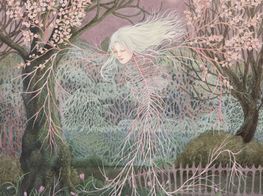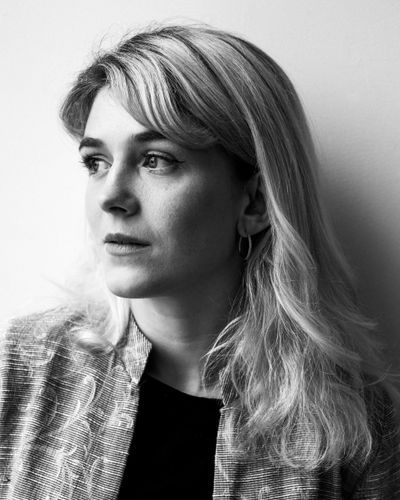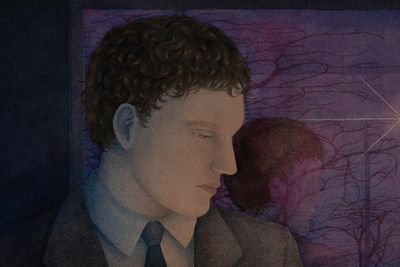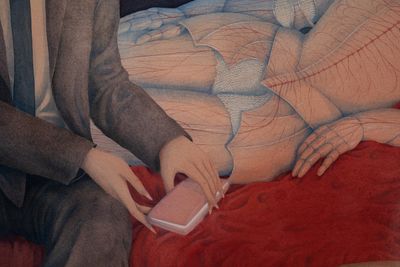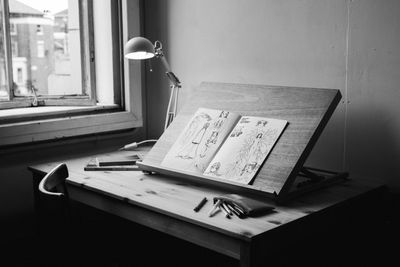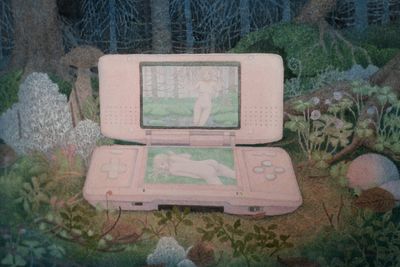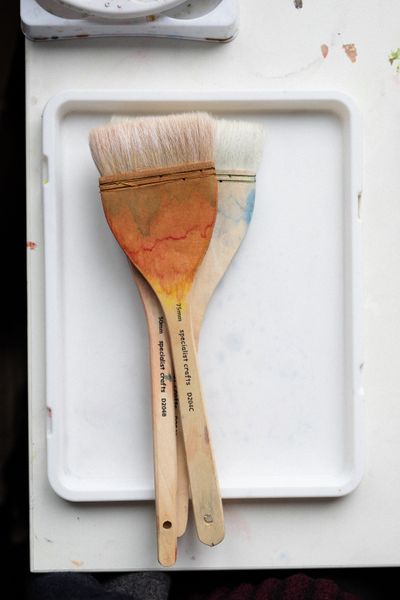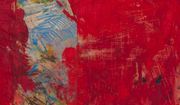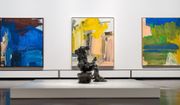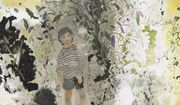
Magical characters and imaginary creatures manifest in Oda Iselin Sønderland's fantastical watercolour worlds. In her latest paintings, the artist renders a distinct perspective on figuration. Filled with rich imagery that alludes to Norwegian folklore and Japanese anime, Sønderland's vivid paintings are a pleasure to behold.
Since graduating from the Royal College of Art in London in 2022, the artist's dreamlike paintings have featured in various shows, including a solo exhibition at NEVVEN in Gothenburg.
Ahead of her group exhibition Shelf Life at Marlborough in London (11 October–11 November 2022), Sønderland discusses her play on perspective, her approach to watercolours, and the latest developments in her practice.
Could you tell us a little about your upbringing and life in Norway?
I grew up in Oslo and lived there until I moved to London last year. Usually, no matter where you are in Norway, you're always close to the forests. For a while, I lived on an island south of Oslo called Malmøya, where I was completely surrounded by forest and sea, with the beach only five minutes away.
Being close to nature has definitely had a profound effect on my work. Too long in London, and I find that my work begins to shift away from nature.
The style of your characters allude to Japanese anime. Was this influenced by the exchange you did to Tokyo during your BA? How was your experience?
My interest in anime and manga started when I was 12, when I was flicking through a friend's How to Draw Manga book. Seeing the emotion and drama within the characters' big, sparkling eyes hooked me in and I was instantly obsessed.
My drawings have of course changed a lot since then, but I feel it is something that lingers in my work still. Its presence is however more subtle now, and has matured. A more recent influence would be the movie director and animator Satoshi Kon, known for Paprika (2006) and Perfect Blue (1997), amongst other films. I think it is the use of drawing to tell stories in a fantastical way—utilising the possibilities of the medium—that I find to be incredibly executed in a lot of anime and manga.
Your work frequently depicts folklore imagery, hybridised with the trappings of modern life. How did you come to explore these themes in your work?
Although it's not a very present part of our modern culture, I grew up with Norwegian folk tales. I wouldn't say that most young Norwegian people are very conscious of or interested in traditional culture, but I think many people know a lot of the common folk tales and are excited when they are reminded of them.
Norway gained its own constitution and independence in 1814, which sparked the national romantic period, which I would say lingers in our culture still. I have seen some contemporary artists bringing up elements from this period in recent years, perhaps coming from a curiosity around identity.
There are a lot of mysterious creatures in Norwegian folklore. One is called Nøkken, a water spirit who lures you into the lake to drown you. Huldra, a forest creature in the form of a beautiful woman, sings an enchanting song to put you in a trance, eventually causing you to lose your way in the forest.
The characters of my own work are inspired by the ones I have read about in mythology and folklore, but I always try to make them my own. They are not meant as a direct reference to a particular culture, but rather I try to understand what aspects of ourselves and our own psychology these characters reflect. My work is often set in environments from our current world and time—my paintings are highly personal and often based on my own experiences. I suppose I am exploring a meeting between a deep desire for complete wilderness or chaos, and social dynamics or constructions.
You play on perspective, creating images within images throughout your work. How do you approach the construction of each painting?
I work with frames in several different ways. Sometimes I frame my work with a painted frame, or with painted imagery around the subject. Other times, the frame is hidden within the painting, like a mirror or a little window to somewhere else.
In Elizabeth Grosz's book Chaos, Territory, Art (2008), there is a section exploring the importance of the frame when creating art. By making art, you are taking a little piece of chaos from the world and framing it into a containable space. In that sense, the chaos becomes comprehensible.
I also relate this to my (limited) understanding of psychoanalysis—you apply a system of symbols and meaning to understand something that seems absurd and mysterious. Although at times these systems can be too rigid, I find the process of it very interesting. Sometimes the frames need to be broken up and reshaped. I think this is in many ways how the world flows, repeatedly containing itself, just to break out and create a new container.
Often in my own work, I think of the inside and the outside as two different worlds. One can be reality and the other can be imaginative, but they both contain elements of the other. Rather than opposites, they are reflections of each other, like a magical mirror.
Your choice of media—watercolour on paper—is fairly atypical, especially in comparison to the heavily oil-based presentations of your contemporaries at the RCA. How did you come to use watercolour?
I started using watercolour when I was 14. When I began my BA I stopped using the medium to focus on line drawing instead, because of the influence of illustration. A few years later, I returned to watercolours after spending time in Japan.
I like the texture of paper and I enjoy the way the paper sips and absorbs the medium. I can work in a way where I dye the paper with colour, remove the top layer to add a new one, and build up the image layer by layer. I'm also interested in exploring how watercolour appears on different sized canvases; I will often work between very small paintings and large-scale works.
So finally, what have you got planned next?
Currently I am exploring more three-dimensional work, mostly in the form of wood carving. I want to find ways to integrate this with my paintings, as I consider those to be the core of my practice. After seeing a medical wax figure resembling Venus at the Science Museum here in London, I fell in love with the idea of creating sculptures in wax or a similar material.
I also want to work on the aspects of myself that are more connected to illustration and storytelling. I'm interested in making comics as I want to explore the possibilities of the medium, and see how my work will take shape in that kind of format.
I hope to make my work more accessible to people who aren't specifically interested in or part of the art world. I feel like making comics can be a change from the structures I experience in the contemporary art world—they can be a product that exists in a form for its own sake, without interfering with the paintings.—[O]
Main image: Oda Iselin Sønderland, Heart of Glass (2022). Watercolour on paper. 105 x 75 cm. Courtesy Ocula. Photo: William Waterworth.

